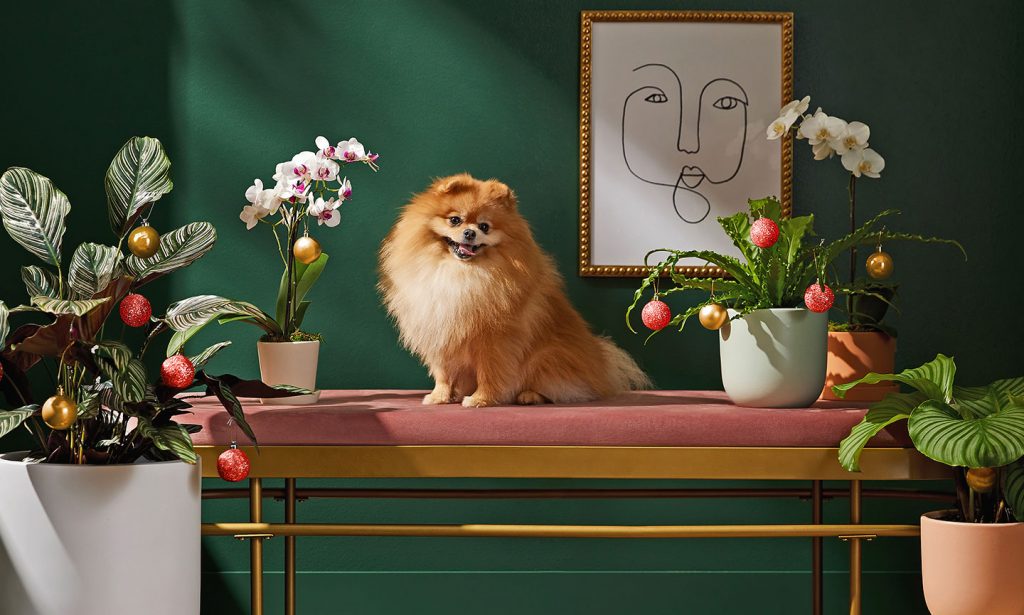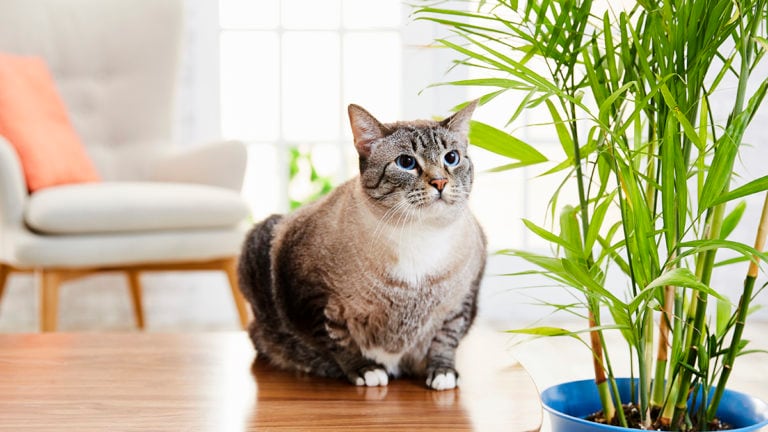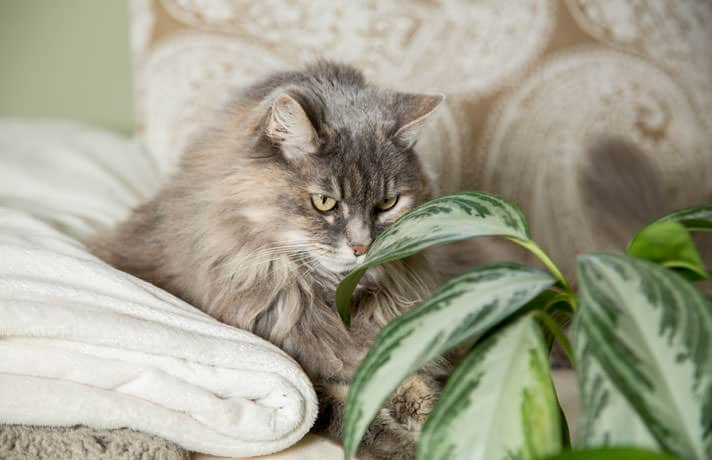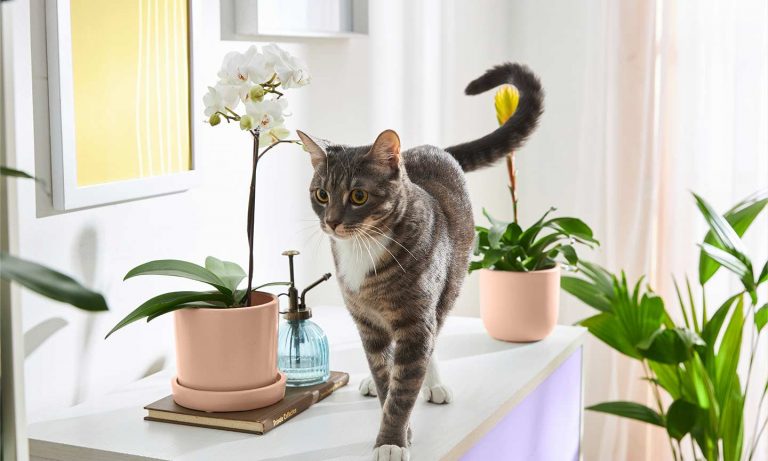Poinsettias, hollies, conifer trees and other go-to seasonal plants that are perfect for decorating your home or to give as cheerful gifts are as much a part of the holidays as cookies and stockings. But these and other commonly used holiday season living plants come with some degree of risk to curious pets who might opt to nibble on leaves, flowers or drink standing water. And while we don't want to scare you off using living plants to deck your halls, it pays to know which pet safe holiday plants are appropriate for homes with furry friends and which might be best to avoid.
We asked the plant experts at The Sill for their advice on pet safe holiday plants to swap for some of the most popular specimens used during the season. These recommended plants still bring the color and charm that only living plants can provide to the long and often darker days of the winter season without risk to your pets. Here is a quick cheat sheet that you can share and below a deeper dig into the whys and why nots of each plant. Shop The Sill's entire pet-friendly plant collection and learn more about their pet-friendly subscription box.
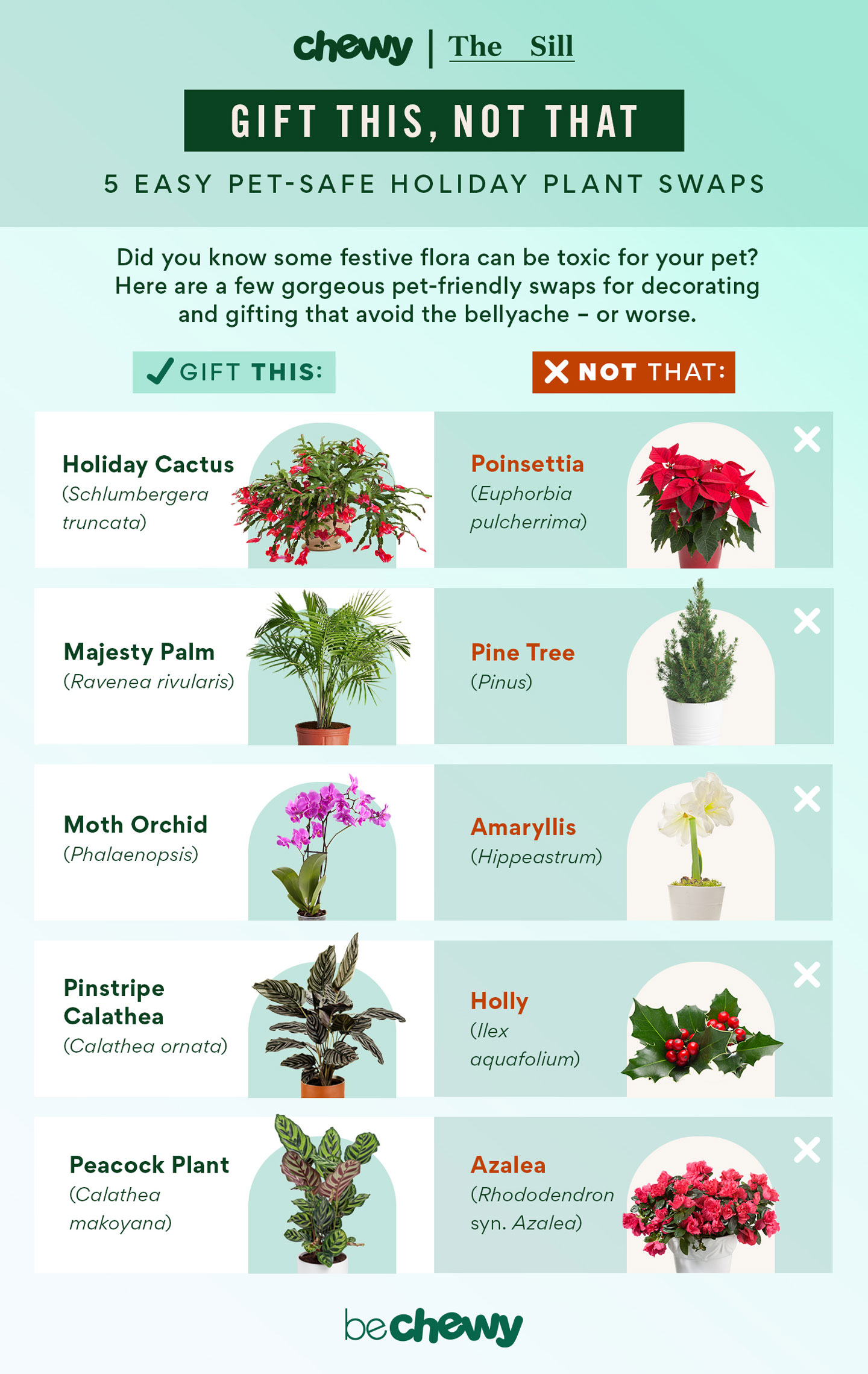
Dig Into the Details of Pet Safe Holiday Plants
Poinsettia (Euphorbia pulcherrima) has a milky irritant sap that, if ingested, can cause irritation to the mouth and stomach, sometimes causing vomiting. While it is not the most toxic plant threat to pets, its not great either! There are other pretty choices.
Holiday Cactus (Schlumbergera truncata) explodes in bright pink or red blooms around Christmas. While it can cause tummy upset if eaten in great quantity, it does not generally pose a health threat to curious pets.
This tough epiphytic succulent needs bright light and high humidity to really do its thing. A sunny window away from heating sources should be enough. Do not overwater; test to see if it needs water by lifting the pot. If it feels light, water.
Pine (Pinus) oils from trees and tree needles can cause upset stomachs in pets if eaten. Of more concern is water in the tree stand that can contain oils as well as leached chemicals used in growing the plant. Other conifers including fir and spruce pose similar risks.
Majesty palm (Ravenea rivularis) when grown indoors, is a slow-growing plant, adding no more than 1 foot per year until it reaches about 10 feet in height. We're not saying it's a one-for-one swap, but it is a good choice for homes with pets who are prone to getting into mischief.
Majesty palm has a reputation for being somewhat of a temperamental plant. It may take a few tries before you find the perfect spot, but this plant typically does well in a bright spot with plenty of light. Give ample, regular water and keep a spray bottle nearby to give it a misting a few times a week.
Amaryllis (Hippeastrum) contains Lycorine and other noxious substances, which can cause vomiting, diarrhea, decreased appetite, and abdominal pain, lethargy, and tremors in both cats and dogs. The bulb of the plant is reputed to be more toxic than the flowers and stalk.
Moth orchid (Phalaenopsis) has the same delicate bloom, cheerful color and Victorian charm of Amaryllis without the possible side effects if consumed by pets. Plus they can bloom for months and come in such a range of colors that there is probably one that's right for every room in the house.
Moth orchids like bright, indirect light. An east-facing window is best; western or southern light is fine as long as it's indirect. When the bark or moss is dry to the touch and the pot is lighter, water your orchid thoroughly (until water comes through the drainage hole in the bottom of your pot).
Holly (Ilex aquafolium) has spiny leaves that usually dissuade most pets from eating large enough quantities to cause serious damage. However, consuming several leaves or berries are likely to cause gastrointestinal distress, such as vomiting and diarrhea.
Pinstripe Calathea (Calathea ornata) has lovely bi-colored veined leaves that, while we won't claim is a "perfect" replacement for holly, has a vibrant foliage-first vibe which is what we're going for here during the dark days of winter when you just want pretty.
This is not the easiest houseplant to parent, but you can do it with a few tricks: provide medium to bright, indirect light; only water when the top 1-2" of soil feels dry; provide high humidity to keep foliage pristine – mist regularly or set on a pebble tray. Easy!
Azalea (Rhododendron syn. Azalea) is toxic to both dogs and cats (the entire plant). Eating just a few leaves could cause vomiting and diarrhea, weakness, difficulty walking, appearing lethargic, tremors or seizures and loss of appetite. Long-term effects can be serious.
Peacock Plant (Calathea makoyana) has long wavy green leaves with a pattern of deep green brushstrokes on top and a deep purple underside. We like that it has the height, scale and robust color of a shrubby azalea plant, but is pet-safe and thrives indoors with a little attention.
Say it once, twice, thrice--this plant loves humidity. Like 60% hair-frizzing levels of humidity. Place away from heat sources in a bright location and place on a pebble filled tray. Better yet, put potted plants into the shower and turn on lukewarm water for steamy gentle rain. They'll love you for it!
Answers to your FAQs from the pros at The Sill
Q:
I am looking for a floor plant. What is a pet-safe option that grows tall?
Q:
What’s a pet-friendly plant that can be kept in low light?
Q:
What are some non-toxic, pet-safe plants that flower indoors?
Q:
What are some non-toxic pet-safe plants for holiday decorating?
Q:
Is there anything else we should know that we’re not asking?
Share:
